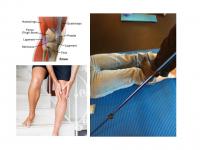Knee problems can be very frustrating. In fact, a painful knee can prevent you from enjoying your favorite things, such as walking, playing golf, exercising, or gardening. There are many instances where knee pain can even interfere with a good nights sleep. To make matters worse many common knee conditions are slow to respond to traditional types of care, often creating further disappointment and aggravation.
How Does Knee Pain Occur?
The knee joint is a synovial joint which connects the femur (thigh bone), the longest bone in the body, to the tibia (shin bone). There are two main joints in the knee: 1) the tibiofemoral joint where the tibia meet the femur 2) the patellofemoral joint where the kneecap (or patella) meets the femur. These two joints work together to form a modified hinge joint that allows the knee to bend and straighten but also to rotate slightly from side to side.
The knee joint is the largest joint in our body. It is vulnerable to injury as it bears an enormous amount of pressure while providing flexible movement. When we walk, the load on our knees is equal to 1.5 times our body weight. When climbing stairs it is equal to 3-4 times our body weight. When we squat, the load on our knees increases to about 8 times our body weight!
In order to move properly and protect the area from injury, the knee joint relies on a complex system of muscles that surround the area.
These muscles include the thigh muscles, known as the quadriceps group, the hamstring muscles, the inner thigh muscles -known as the adductor group, the calf muscles, and also some smaller muscles around the knee, such as the popliteus muscle. Underneath these muscles there are also several strong ligaments that help protect the knee joint. When the muscles are all working properly, the knee moves as it should and the chance of pain and injury is very small. Unfortunately, it is common for these muscles to become tight and weak, which can lead to a variety of knee problems.
How Does Injury Occur?
We rely on the muscles that support and control the knee with virtually all of our daily activities. If any of the muscles that surround the knee become tight or weak it will place excessive strain on the other muscles and on the knee joint itself. Over time, if this imbalance in the muscles and resulting abnormal knee motion is allowed to continue, it can eventually develop into more severe knee conditions.
There are a variety of situations that can cause pain, weakness, and abnormal function of the knee. For example, repetitive use with certain sports or occupations, poor posture, lack of use, lack of stretching, muscle imbalances, or previous injuries can all affect the normal function of the knee and surrounding muscles, resulting in excessive strain to the area.
Over time, this strain can develop into what is known as micro-trauma. Microtrauma is the microtearing of muscle fibres, the sheath around the muscle and the connective tissue in the response to small levels of strain. Initially this micro-trauma is not painful, but may be perceived as a mild ache or tightness in the muscles. The body responds to micro-trauma in a predictable way, by laying down small amounts of scar tissue to repair the injured tissue. Unfortunately, over time this scar tissue will build-up and accumulate into what we call adhesions. As these adhesions form, they start to affect the normal health and function of the muscles. In fact, they will often lead to pain, tightness, stiffness, restricted joint motion, and diminished blood flow.
Now for the good news, a powerful technique known as The Rossiter Stretching is proving to be very effective method to treat many common knee problems. These techniques effectively relieve pain because they stretch out entire bands of connective tissue. They usually get rid of pain and restore fluid, pain-free motion to entire areas of the body.
As we already know connective tissue holds our body together, but it can shorten and tighten over time through overuse (such as poor posture, or repetitive a daily activity) or from an injury. Rather than general stretching, Rossiter stretching, targeting the connective tissue is done with the assistance of the practitioner, and unlike a passive massage treatment, you as the patient are in control of depth of the work and stretch.The technique involves a practitioner applying pressure to specific areas of the body, to anchor the tissues, while you are guided through movement to actively stretch that particular part of the tissue network. Results are quick, profound and life-changing. You regain and increase range of motion.
If you are ready to take care of your body in a whole new way, the Rossiter System’s breakthrough techniques are for you! This is a powerful new way to prevent and relieve pain, regain and increase range of motion, and enhance performance. There are no medications, no splints, no injections and no risky surgeries.
To book an appointment simply call us: (405) 942-4111 or (405) 728-500

